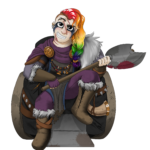10 Steps to Adventuring in a Wheelchair

How can a character in a wheelchair be an adventurer in Dungeons & Dragons or other fantasy roleplaying games? While I recently noted that ramps should be more common than expected, no matter how accessible your world is, you’ll eventually encounter rough terrain of some kind. Does this make adventuring in a wheelchair impossible?
1. Rough terrain is hard for everyone, thus the name.
Probably the most common question I get: “How can a person in a wheelchair navigate [some kind of terrain]?” This seems to assume everyone else has no problem. It’s called rough terrain for a reason. It’s difficult for nearly everyone to cross. It’s like a merfolk asking how you could navigate the ocean with those finless legs. You’d use an assistive device like a boat.
Different environments present different challenges for different people, disabled or not, but it’s easy to think from an able-bodied perspective and make assumptions based on our own experiences, calling the difficult “impossible” instead of making it “accessible”.
2. Ambulatory wheelchair users exist.
Many people think that anyone in a wheelchair must be paraplegic, but many wheelchair users can walk — it’s difficult, painful, or exhausting, but they may well be able to traverse a 10 foot staircase, possibly needing to take a short rest after and find a different means of retrieving their wheelchair from below.
Real-world ambulatory wheelchair users frequently face scorn from people who see them stand up to get something off a shelf or for some other purpose and criticize them for “faking it”. Don’t do that, and don’t make assumptions about fictional characters’ capabilities, either.
3. Are you adventuring alone?
While certain encounters may be difficult for any given individual to navigate, most adventuring parties consist of multiple characters working together. The caster levitates the rogue over the pit. The barbarian protects the caster. The walking party member assists the wheelchair user up the steps. That’s the whole point of a balanced party.
4. Wheelchair users can traverse steps alone.
See for yourself.
5. I present to you the Ramp spell. (or Floating Disk)
If you have a member of the party who can cast Floating Disk, they can put it under your wheelchair, and it will traverse anything an able-bodied person can. (See #3 above.) If not, I offer this alternative so you can do it yourself.
Ramp
1st-level conjuration (ritual)
Casting Time: 1 action
Range: 30 feet
Components: V, S, M (a wood or stone wedge)
Duration: 10 minutes
This spell creates a plane of force, 6 feet wide, 1 inch thick, and up to 30 feet long, that connects 2 solid objects through an unoccupied space of your choice that you can perceive within range. The plane remains for the duration and can hold up to 500 pounds. If more weight is placed on it, if you move more than 30 feet away from it, or if one of the connected objects moves beyond the length of the plane, the spell ends, and everything on the plane falls to the ground.
At Higher Levels. When you cast this spell using a spell slot of 2nd level or higher, the plane length increases by 20 feet for each slot level above 1st.
6. Rope exists in D&D.
You can either have a couple party members tow your chair over the steps or use a grappling hook and Batman the steps by yourself.
7. Some terrain is easier in a wheelchair.
If you’re in a wheelchair, you’re not likely to be knocked prone by slippery surfaces, so you’re effectively immune to the Grease spell or other effects that make the ground slippery unless sliding down a ramp, and even then, you probably won’t end up prone once you get to the bottom.
8. Heat Metal is a bigger problem for martials than wheelchair users.
I’ve seen comments that those in wheelchairs are vulnerable to Heat Metal. That assumes the wheelchair is made of metal instead of wood, bone, or some other substance, but even in that case, it probably takes a reaction to push yourself out of a chair until the spell ends. Armor takes 1–5 minutes to doff. The paladin will want help from the wheelchair-using rogue in that case, and is anyone really going to burn a 2nd level spell and their concentration on an escapable wheelchair when they could be turning the fighter into a baked potato?
9. Dodging in a wheelchair.
Can you dodge in a wheelchair? Given that dodging is an action in 5e, there’s no reason you couldn’t. Paralympians and other wheelchair-using athletes can move with amazing speed and dexterity. Add the superhuman nature of a 5e hero, and players should have no problem imagining this.
10. D&D is a game of creative solutions — that’s what separates it from video games.
I am not disabled, and it took me 20 minutes to compile this list of ideas before researching the details. Were I a disabled adventurer, I’d have a lifetime of ideas how to manage various obstacles. Many people who can’t imagine navigating these obstacles may benefit from honestly attempting to play as a disabled character, to take some time to think and research both accessibility and others’ lived experiences to expand their awareness. Others may choose a magical solution like the hovering capability of the Combat Wheelchair. But it’s D&D — anything is possible, limited only by your imagination and the parameters established at your table.